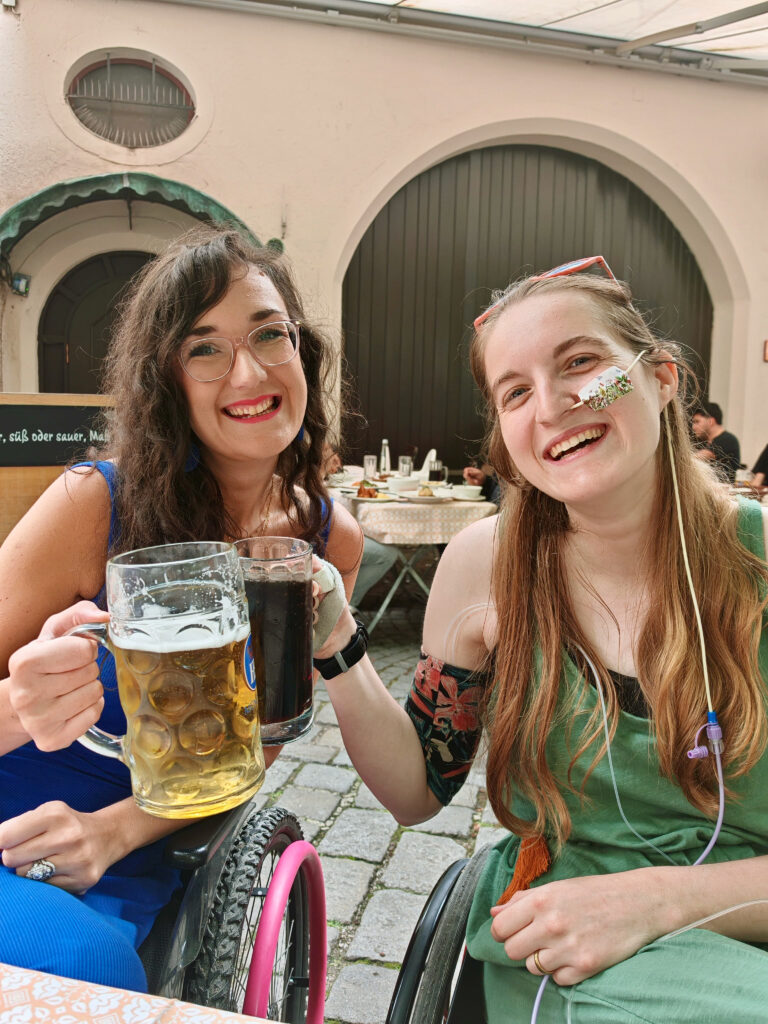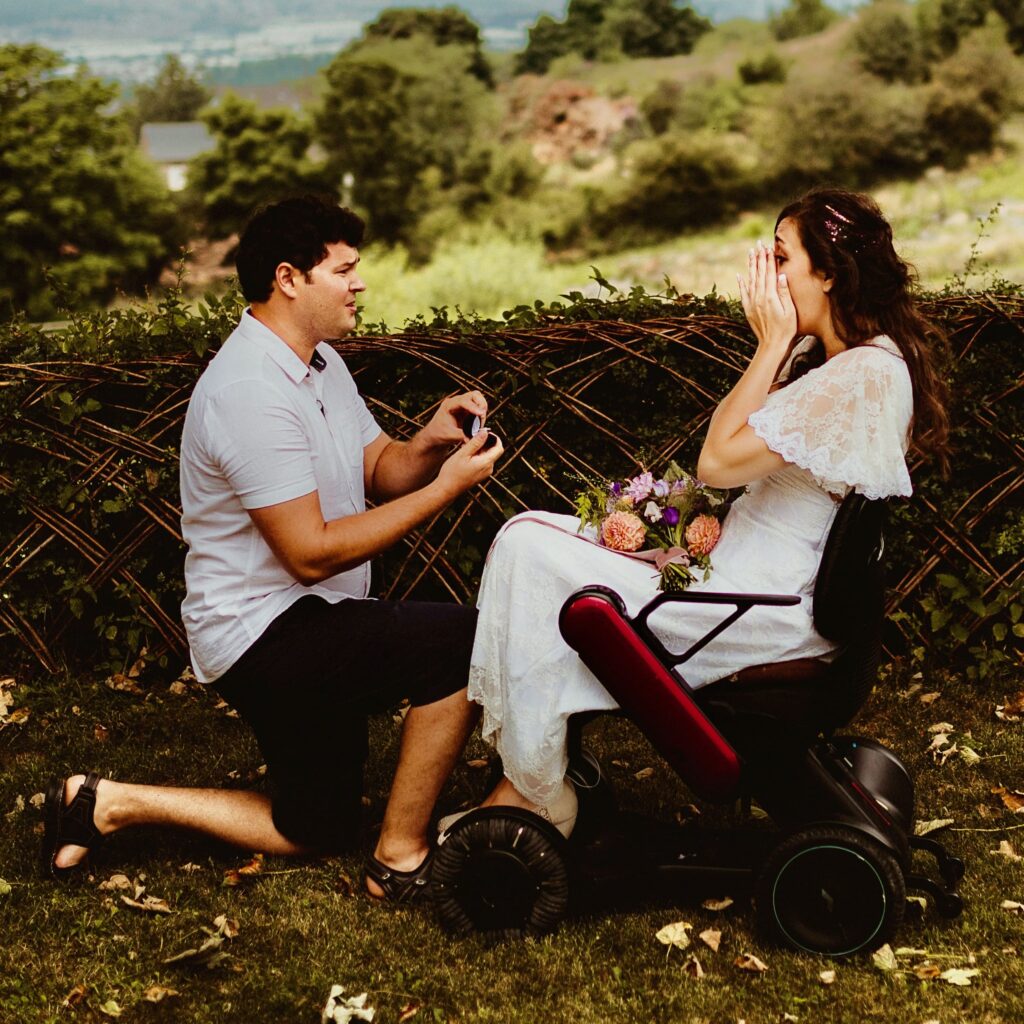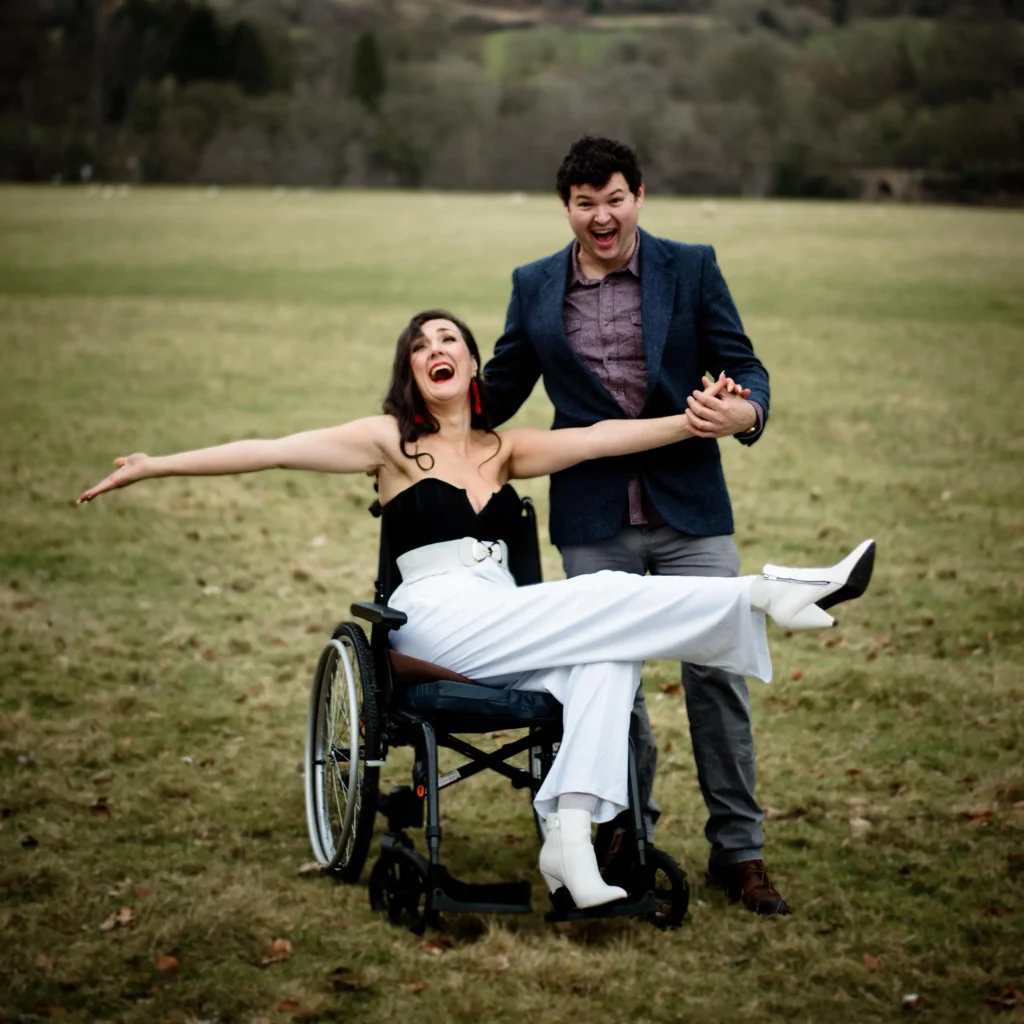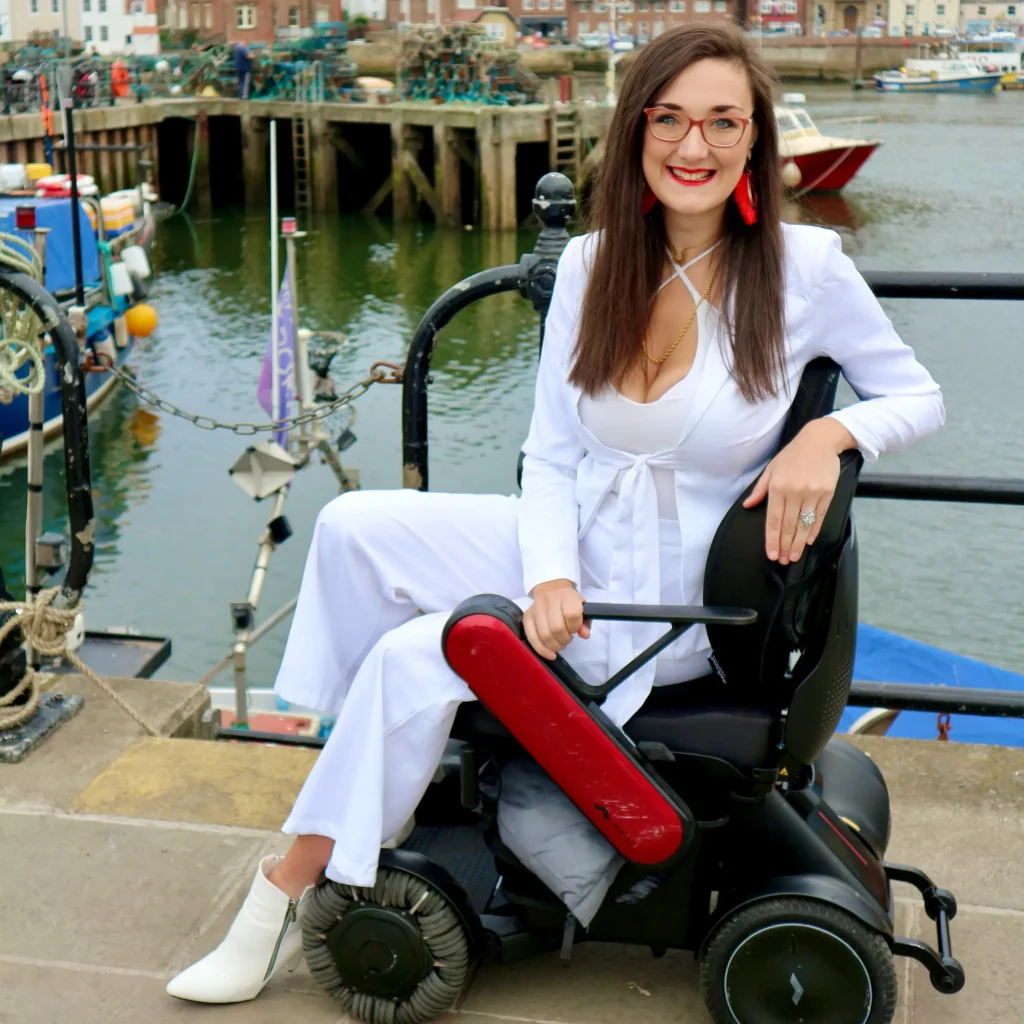Richard and I were kindly invited to review Hofbräuhaus in Munich and check out
their accessible beer tavern. As always, all of my opinions remain my own and this
piece is genuine and authentic.

You’ll notice that Richard and I have various outfits on within this blogpost; this is
potentially the biggest sign that we truly loved our food, drink and overall
experience at Hofbräuhaus. We returned many times during our time in Munich,
both as a couple and with our friends Mary & Tim who were travelling alongside us.
We just enjoyed the overall experience so thoroughly that we decided to dine there
on multiple occasions during our stay in Munich.

Hofbräuhaus is a historic building in Munich centre with a very traditional Bavarian
cuisine, drink and atmosphere. I was really pleasantly surprised that a building that
was established in 1589 was as wheelchair-friendly as it was! There were
accessible bathrooms on every floor of the tavern, smooth terrain underfoot
indoors with tiled restaurant floors and even elevators to take you to the vast
majority of the building. The design of the exterior building is visually stunning with
flower boxes lining the upstairs window, Hofbräuhaus blue & white flags flying and
golden lettering, labelling this celebrated building. Although many areas of the
building were sadly fully or partially destroyed during WWII, there has beenextensive effort to refurbish in an authentic way. The upstairs Festaal (Festival Hall)
remains in its opulent and original grandeur. I will show you some photos of this
truly breath-taking sight later in this article.


You enter the Hofbräuhaus main glass doors from the historic cobbled street.
Although some of the pathways or pedestrianised roads in Munich do involve
cobbles, they are surprisingly wheelchair friendly and many dropped curbs can be
found.


Once you traverse the small lipped curb to enter under the Hofbräuhaus arches,
you can go to multiple entrances. The entrance to the left is for reservations of
groups of four or more only. You cannot actually reserve seating within the
bustling, vibrant main beer hall in the main glass doors on the right. I would
recommend getting there fairly early or just being patient until tables become
available. There is always a high turnover of guests who have finished their
drinking/ dining experience so just be patient where possible. You are seated
“family style” so can join other diners on their banquet style tables or you can
source tables for specific party sizes in the exterior courtyard. Within the courtyard
there were far more tables for smaller group sizes. Honestly, I really enjoyed the
fact that you sat alongside other people as it made the experience far more
sociable if you wanted to chat to other tourists or locals alike. One lovely regularinsisted I borrow his traditional Bavarian hat since I was not wearing the authentic
dirndl costume myself that day.


Regulars are often seated at their preferred tables for pre-organised events. Never
worry about accidentally sitting on one of these tables as they will always have a
clear reservation sign. Hofbräuhaus has a thriving community of regular attendees
at their events or to dine or drink in the beer tavern. There are around 3,500 regular
patrons of Hofbräuhaus but only 616 of them are given the ultimate honour of
having their own personal beer stein housed within the special locking system
within the main beer hall. Some of these steins are family heirlooms and could be
up to 100 years old. Unfortunately, some of the true original steins were taken
home as souvenirs after Munich was occupied by the Americans at the end of
World War II. Some real treasures must be out there but even seeing the steins that
still exist in Hofbräuhaus was an honour.



Each of these 616 patrons has their own padlock and are even responsible for
washing their own stein in the nearby sink. A fun fact that I didn’t know about was
the reasoning behind there often being a flippable lid on top of a stein. The
supposed use for this (beyond keeping your beer fresh and debris-free) is to signal
the waiting staff. If your stein lid is left open then this signals the waiters or
waitresses to come and fill your stein up with more beer. A lid left closed means
you are still drinking this current beverage or you are finished drinking. Our glass
steins felt like a wonderful excess and something that set this dining/ drinking
experience apart.

The waiting team at Hofbräuhaus were so pleasant; they helped by getting us an
English language version of the menu whenever we dined or had drinks at the beer
tavern. They all wore traditional Bavarian outfits such as the lederhosen and dirndl
for males and females respectively if worn traditionally. It felt fun and atmospheric
to see these outfits being worn proudly by the staff and by the regulars! I originally
thought that Hofbräuhaus as a whole, but particularly the traditional Bavarian
costuming, would feel “touristy”. In fact, you could see the quality of the outfits
and could feel the years of history that had occurred within the walls of the beer
tavern and the festival hall above. Many years of historic visits and pivotal
moments happened within the walls of this venue, some good and some bad, but
all worth honouring and acknowledging.


The whole dining experience felt so much more laid-back than any I had
experienced within the UK or USA. You seated yourself at your leisure and the
(very busy) waiting staff came across with a menu, to take your order and to serve
you at a more leisurely pace than I am accustomed to. Although the pace of the
meal was less timely than I am used to, it actually allowed my husband and I to
soak in the experience, the camaraderie between tables and to truly revel in the
sights around us. The coved ceiling above us had stunning painted artwork
throughout the entire tavern. You could also see historic signs hung from the
ceiling to mark where particular regulars at Hofbräuhaus would conventionally sit.


We could also enjoy the tunes that the traditional Bavarian folk musicians were
playing. With instruments such as a tuba, accordion and a guitar, the music was
always upbeat, punchy and gave such a vibrant atmosphere to the whole
experience. I think that’s something to note about Hofbräuhaus as a whole; it isn’t
simply a stein of beer or a meal out, it is a decadent experience where you are
transported into a community and into the past.


The entrance to the building was easy for me in my wheelchair since the double
glass doors were propped open. There were also porters (doormen) situated by
these doors so there would be no problem getting them to open the doors if the
weather was perhaps bad.

Directly to your right as you enter the main beerhall is a gift shop. This sold the
steins you drunk from at Hofbräuhaus and other fun gifts such as magnets, toys
and bottle openers. You can actually buy the different types of beer sold at
Hofbräuhaus (more on these types later) during Oktoberfest, Munich festivals and
in bottled form globally.
As you enter the cavernous beer hall, you are bombarded with a whole sensory
experience. You can hear the music, see the crowded and popular room whilst
smelling the traditional food on offer. I also loved that they had pretzel and cookie
sellers who milled around the area, offering these delectables so you could either
sample them there, or even take the pre-packaged iced cookies home with you. It
is worth noting that this specific aspect of the dining experience is cash-only if you
buy from the cookie/ pretzel sellers.
The paper menus were on offer in a multitude of languages or you can find them
here to translate on your phone into your preferred format. This is also very helpful
for those who are blind or have vision impairments as they can then enlarge the
text on their devices. Similarly, there is a huge list of specific allergens on this pageso those with dietary requirements or restrictions can still enjoy their Hofbräuhaus
culinary experience.


We ate so many delectable dishes during our visits here whilst we were in Munich
so I will go over some of our favourite dishes in more detail. Hofbräuhaus is
famous for their local ingredients and even have some grains grown, harvested
and delivered from right next door! I think you could particularly see the quality
ingredients in the meats that they used. Bavarian cuisine is traditionally very meat-
heavy but there was also a comprehensive vegan and vegetarian section on offer.
A Brotzeiten is a traditional German platter used to snack/ graze on whilst drinking,
or to use as a light-bite for lunch. The Bavarian ‘Brotzeit’ platter was particularly
great as it allowed me to sample a large variety of different sausages, cooked/ raw
hams alongside some house bread & butter and sides such as radish, salad and
obazda. Obazda is a textured cheese dip or soft cheese. It had a tangy, creamy
taste with a smooth yet curdy texture. Some people eat this alongside a salad as a
topper but it is traditionally used as a dip for pretzels or bread.


If you want to sample another range of Bavarian delicacies then the sausage
platter is a really good option. These sausages are served over a bed of traditional
sauerkraut pickled cabbage. I loved this selection as it allowed you to taste a few
of the more popular sausages, including the Pfälzer sausage which a mixture of
beef & pork, the Wiener sausage which is parboiled and smoked to give a delicateflavour and the rich and meaty Hofbräuhaus pork sausage. You could also sample
the boiled white veal sausage which had a delicate herby flavour.

Richard loves pork in general so was absolutely delighted to see an array of meat
cuts o offer. He chose the pork knuckle which was a hefty, generous piece of meat.
This arrived with rich crackling and a potato dumpling. I read about the marination
process that Hofbräuhaus have perfected as dark beer is poured onto the knuckles
during the roasting process. This is served with a dark beer gravy.

For dessert, I would highly recommend the Kaiserschmarn which is a traditional
dessert that originates from Austria. There are a few varieties of this but
Hofbräuhaus serve their dish without raisins stirred in. These are thick, fluffy
pancakes (similar to American pancakes) which are then shredded, re-fried until
golden and served with a tangy apple sauce. A really decadent treat! I love
sampling foods that are variants of the cuisine we usually see in the UK.

Our tables when seated indoors had bench-like seats designed for communal
dining. However, I had no problem in pulling my wheelchair to the head of the table
if I chose to not transfer. To get to the outdoor courtyard, there was a small step
but I personally had no problem with this with my husband’s help. The courtyard
contains a central statue column, rich greenery and tables for a smaller amount of
guests. Be aware that the terrain underfoot is more traditionally cobbled so my
wheels were slightly harder to propel.


There are more seating areas in a balcony around the courtyard area but I could, of
course, not climb these steps. My abled husband kindly went up to take a few
photos. I could absolutely see that these tables had a lovely, panoramic view over
the courtyard below.



Inside, there is a large accessible toilet. I had no problem manoeuvring my
wheelchair within the room and could easily spin my wheelchair to exit the door
facing forwards. There were foldable grab rails to either side of the toilet to allow
side transfers. Be aware that the sanitary/ waste bin was not quite within reach of
a seated position on the toilet. There was an emergency alert cord (it is white, not
red so not very visible) but it was often looped up during our visits. Just be aware
that it did not reach the floor in the event of a customer falling so you may have to
unhook this when using the accessible toilet. The hooks were a great touch to
hang up coats when using the toilet and there were a few at both seated and
standing heights.

I could easily reach the lowered sink and there was a full mirror which would work
whether you are at seated or standing height. I also had no issue reaching for the
drying tissues and bin. This is great to see as self-propelling with wet hands is hard
when the tissues are not within easy reach of the sink.

There were also accessible toilets on the upper floors where the Festival Hall is
located. I did not enter these as those floors were actually closed to the public
when we visited and the toilets were locked with a EuroKey (European equivalent
of a RADAR key). They would be unlocked if the upper Festall (Hofbräuhaus
historic Festival Hall) was open.We didn’t attend Hofbräuhaus whilst there was an event running but the upstairs
Festival Hall is host to many events throughout the year, open to both tourists and
locals alike. We were lucky enough to be in Munich during the Kocherlball though
where traditional Bavarian dancing (and drinking!) takes place within the central
Munich gardens, by the Chinese Tower. This sunrise festival was traditionally
celebrated by all of the cooks and servants of the city as they were given one day
off to dance and celebrate. You can attend optional, free dance classes in advance
of this event to fully know the classic Bavarian dances. These are specific routines
and are not currently as well-known in modern society. The fact that you can
rehearse these in such an opulent, historic building of the Hofbräuhaus Festival
Hall feels like a nod to all of the history that has previously occurred within these
walls.



Of course, the Kocherlball involved lots of dining and drinking. The Hofbräuhaus
beers were available for sale there during the event. I loved the variety in the menu
within the beer hall itself. You could sample many wines, spirits, hot drinks or non-
alcoholic drinks but Hofbräuhaus is of course very famous for their beers. You
order the beverages in a 1 litre or 0.5 litre stein which feels so indulgent and
unusual for someone from the UK. It felt very much like a community, joyous
atmosphere particularly in the evening where tourists and locals alike were drinking
from these impressive, large steins.
There were four main types of beer on offer when I visited with Richard (summer
2024). The Hofbräu Original was a bitter with a mild, moreish palette. This is the
particular variety that is often available on draught throughout Munich and can bepurchased in bottled format worldwide. I really enjoyed this variety as it felt less
intense than the characteristics of some UK beers.


If you wanted that “punchy” flavour then the Hofbräu Dunkel Dark Beer might be
the best option. This felt closer to the original Bavarian roots and had a rich, deep
palette with intense flavours. You can enjoy both this Dark Beer and the Original
beer as a “Radler”. To my UK readers, we know this as a “shandy” where the beer
is mixed (often in a 50:50 ratio) with lemonade, giving it a sweeter and more
refreshing taste. Perfect for those who want to try the beer but are not usually
beer-drinkers.
A similarly mild choice was the Hofbräu Sommerzwickl which is a seasonal beer
only available in the summer months. Hofbräuhaus rotates between four different
seasonal beers, each with strongly different tastes. Drinking the Sommerzwickl
variety felt so idyllic in the Munich heat when we visited. It was a delicate beer with
an almost fruity, effervescent taste. I would say that it would suit most palettes,
even those of the beer-averse!
An alternative to all of these was the Hofbräu Wheat Beer (Münchner Weisse). I am
definitely no beer connoisseur but I swear this variety felt more sparkling and
bubbly than the previous options. It was slightly sweet but rather tangy and tingly;
you could definitely discern the wheat and the alternative brewing conditions.


Of course, your favourite beer is very much personal preference but all of these
varieties paired well with the food, camaraderie and the delights within
Hofbräuhaus. I was really pleasantly surprised that I felt immersed in a cultural,
historic atmosphere that did not feel overly “touristy” or contrived. The access
throughout Hofbräuhaus was really great; I never struggled to get my wheelchair
into any of the lifts, I found the toilets accessible for my needs and there were only
a few cobbled/ stepped areas to say how historic and architecturally stunning the
building was. We loved the traditional food, music and the beer-drinking culture.
We even made a few new friends on a “regulars” table next to us who were really
friendly and hospitable.


Thank you again to Hofbräuhaus for allowing my husband and I to visit. We
became repeat customers throughout our stay in Munich and immediately brought
our lovely friends, Mary and Tim, alongside us for our next visits. Our experience
felt carefree, fun and enriching. We will absolutely be back when we visit Munich
again.







